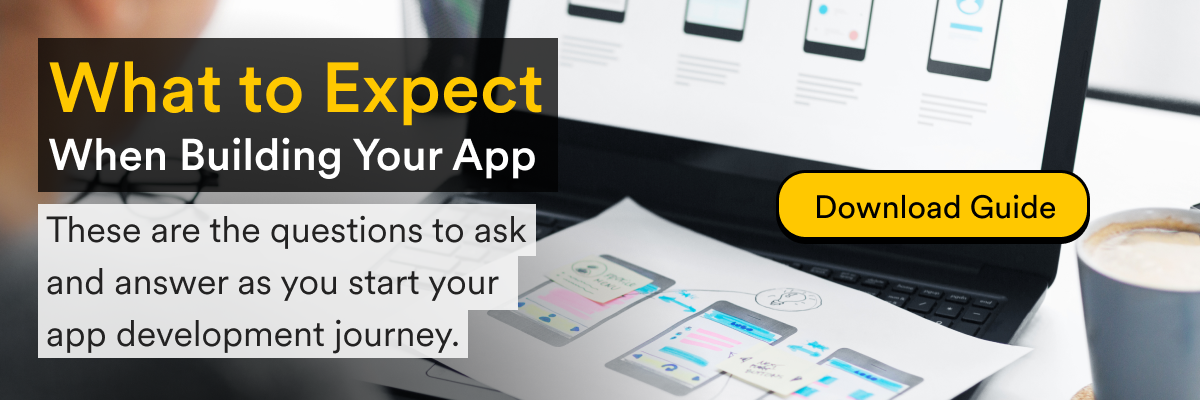
You know it, we know it, your five-year-old nephew who’s glued to his iPad may even know it: Tech is more intertwined with business than ever. You need customers to glide between multiple touchpoints (e.g., your app and website), you need analytics for forecasting, and you need to use digital tools to shave costs and crank up efficiency.
But what about the digital experience for your employees? It’s a piece that’s easy to forget, but is increasingly important. Empowering your employees with digital tools leads to happier and more productive team members, setting the tone for your organization’s entire ecosystem.
Dig into how the digital experience affects your organization and how a relatively new technology—a digital experience platform (DXP)—could reshape it for the better.
Download our guide, What to Expect When Building Your App. >>
What is a digital experience?
If you’re reading this, you’re likely familiar with some aspects of the digital experience. The digital experience describes the interactions your company has with customers, users, or employees through technology. Think websites, mobile apps, e-commerce sites, social media, smart devices, and every piece of tech that drops a digital impression on an individual.
The easier a person can weave between those digital dimples, the better their digital experience. And the same goes for the company internally. When a company undergoes a digital transformation, it shaves down those digital touchpoints so teams can seamlessly flow from one digital task to the next, increasing efficiency.
What is a digital experience platform?
So what if your organization has digital touchpoints that are disconnected, numerous, or hard to control? That’s when the hero saunters in: a digital experience platform (DXP). A DXP lets your company manage, deliver, and build out its digital experiences in one place.
“Isn’t that what a content management system (CMS) does?” A CMS is limited to managing content, but a DXP can tackle a wider swath of digital touchpoints and combine multiple channels. For instance, in a DXP, you can control:
- Content management.
- Multi-platform support.
- Delivery and presentation of content and experiences.
- Personalization.
- Analytics and optimization.
- Search and navigation.
- Customer data management.
- And more!
How does a good DXP benefit a company’s ecosystem?
Which came first, the happy customer or the happy employee? It may be impossible to tell because when it comes to building a positive digital experience, customer experiences and your employees’ work quality are entangled. Happier customers or users mean happier employees. More efficient employees shape better customer experiences.
A DXP can enhance employee and customer experiences, strengthening your company’s entire ecosystem. Here’s how:
Streamline work and processes.
According to TechRepublic, 84 percent of employees say having the correct software frees them up for non-work activities. Business software and digital processes should make employees’ jobs easier, but sometimes they do the opposite.
If employees have to fumble through various channels, log into multiple platforms, or wrestle with clunky digital tasks, it can be frustrating—and potentially cause them to leave. According to Enterprise Strategy Group, 25 percent of employees and candidates say poor workplace technology is enough to influence their decision to either remain in a position or accept a new one.
This is one major way a DXP can save the day. A DXP cuts out extra friction points that employees have to swerve around during the work day. It lets them handle cross-functional tasks—such as gathering and analyzing user data, building content, and managing content—all in one place. In turn, they have more time and feel happier, leading to more positive workdays.
Break down silos.
Remember the cubicle days when you had to stand up and call out over an eye-high wall to ask a coworker to pass the stapler? We’ve made plenty of progress since then, but some of those work silos crept into the digital experience.
If people work in bubbles, projects run slower, information falls through the cracks, and work quality and customer experience can suffer.
A good DXP makes it easier for employees across teams to communicate, share data, and collaborate. It provides a single interface to drive more alignment across teams.
Build intelligence into every business process.
Companies constantly gather useful information about customers. What if you could capture and use internal intelligence to strengthen your workforce? That’s another way DXP can boost your company’s ecosystem. For instance, it lets you track important metrics that can inform big-time decisions, such as employee longevity, full-time or part-time status, and skill level.
It also makes it possible to see how employee experiences influence the broader organization—and correct course, if needed. For instance, you can dig into well-being reports, team diversity figures, and training updates. Combine that people data with financial data, and you’ll be set to build an even stronger company.
Improve the user experience.
Ask any parent, and they’ll tell you: “Kids need consistency.” So do full-grown customers. If your customers and users get one message on your website and another on your mobile apps or in-store kiosk, they may not throw a tantrum, but they will be frustrated.
A DXP unifies your channels so you can deliver the same experience across your digital ecosystem. That means your websites, mobile apps, in-store kiosks, and drive-through displays match up—kicking your digital experience into high gear.
They also make it easy for your teams to drop content into new platforms without creating a new CMS for every fresh piece of tech. So rather than rebuilding for every new VR program or digital device, you can pull from your existing content and easily add it to the new or emerging technology—saving resources and adding more consistency to customer experiences.
Personalize experiences.
Ever had a new acquaintance call you by the wrong first name? It’s awkward, maybe even irritating, and an overall unpleasant experience.
The same goes for a user’s experience. The best user and customer experiences are personal. It makes them want to connect with content, ads, and products that fit their interests.
A DPX makes it easy to deliver personalized experiences across multiple channels. It also organizes customer data and gives you a clear picture of the customer at every stage of their journey—making it easier to personalize alongside them.
Enable collaboration.
You don’t need a pep talk to know how important collaboration is to your organization. You already know more teamwork means a more productive, higher-functioning workforce. It’s another way that DPX can enhance your whole organization’s ecosystem.
Of course, DPX gives you an interface in which teams across departments can input and edit content, but it includes even more team-melding capabilities. For instance, an advanced DPX includes built-in or customizable workflows that make it easy to collaborate, make edits, get approvals, and push forward together.
Supercharge your company’s digital experience.
The digital experience drives your entire organization’s ecosystem, from the quality of work for your employees and customer experiences to overall productivity, company workflows, and everything in between. And a DXP can help your organization smooth out that digital experience—enhancing every corner of your company.
Want to learn more about tech and the digital experience? Subscribe to our blog now, and we’ll send you free resources about how digital technology can help your business thrive.
